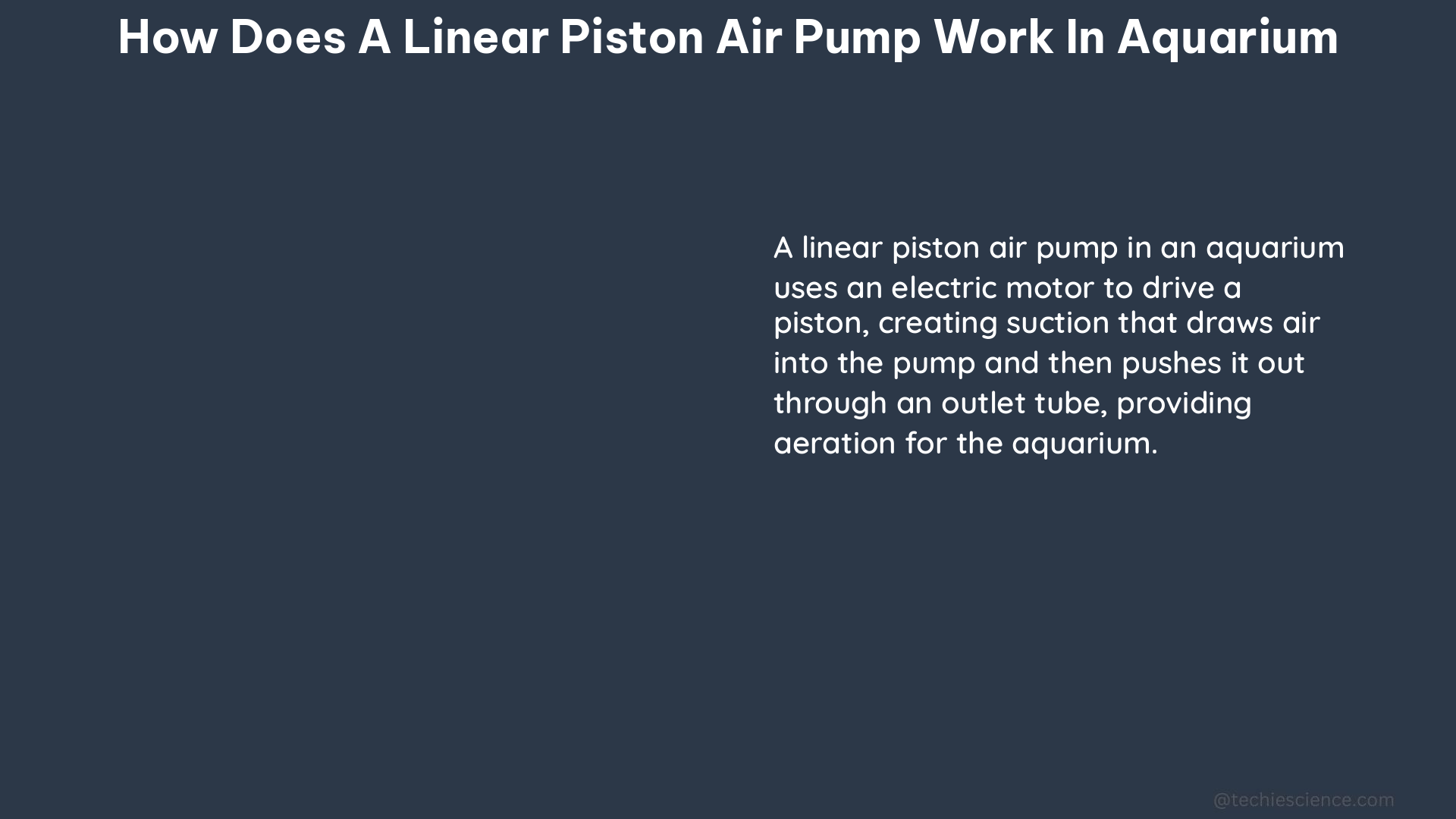A linear piston air pump is a highly efficient and reliable device used in aquarium setups to provide a steady supply of air. These pumps operate on the principle of a linear piston that moves back and forth, creating a vacuum that draws in air and then forces it out. This motion is powered by an electric motor, which drives the piston via a crankshaft. Let’s dive into the technical details of how these pumps work and explore their key features.
The Mechanics of a Linear Piston Air Pump
At the heart of a linear piston air pump is the piston, which is the only moving part. The piston is designed to float on a bed of air, reducing wear and tear and increasing the pump’s durability. This unique design allows the piston to move back and forth smoothly, creating the necessary vacuum and air pressure to drive the air flow.
The electric motor that powers the pump is typically rated between 35-60 watts, providing enough energy to deliver air flow rates ranging from 20 to 60 liters per minute. The motor’s rotational motion is converted into the linear back-and-forth movement of the piston through a crankshaft mechanism.
As the piston moves, it creates a vacuum on the intake stroke, drawing in air from the surrounding environment. On the exhaust stroke, the piston compresses the air and forces it out through the outlet, where it can be directed to the aquarium using PVC pipes or airline tubing.
Key Features and Benefits of Linear Piston Air Pumps

-
Durability and Longevity: The linear piston design, with the piston floating on a bed of air, allows these pumps to operate for up to 8 years continuously without significant wear and tear. This makes them a reliable and long-lasting choice for aquarium owners.
-
Quiet Operation: Linear piston air pumps are known for their quiet operation, which is a significant advantage in a home aquarium setting. The smooth, efficient movement of the piston minimizes noise and vibration, creating a peaceful environment for both the aquarium inhabitants and the owner.
-
Energy Efficiency: Typically operating at 35-60 watts, these pumps are relatively energy-efficient, helping to keep your aquarium’s running costs low.
-
Clean, Oil-Free Air: Linear piston air pumps do not require any oil or lubricants, ensuring that the air they deliver to the aquarium is clean and free of contaminants.
-
Versatile Placement: The compact size and lack of vibration allow linear piston air pumps to be placed in a variety of locations, including inside the aquarium cabinet or on a nearby shelf, without causing any disturbance.
-
Easy Setup and Maintenance: Connecting a linear piston air pump to an aquarium is a straightforward process, using PVC pipes or airline tubing. Maintenance is also minimal, with only occasional cleaning required to ensure optimal performance.
Technical Specifications and Considerations
When selecting a linear piston air pump for your aquarium, it’s important to consider the specific technical specifications to ensure it meets your needs. Here are some key factors to keep in mind:
-
Air Flow Rate: The air flow rate, measured in liters per minute (LPM), is a crucial factor in determining the appropriate pump size for your aquarium. As a general guideline, you’ll want to choose a pump with a flow rate that is 2-4 times the volume of your aquarium in gallons. For example, a 50-gallon aquarium would benefit from a pump with a flow rate of 100-200 LPM.
-
Power Consumption: Linear piston air pumps typically operate at 35-60 watts, but it’s essential to check the specific power consumption of the model you’re considering to ensure it aligns with your energy requirements and budget.
-
Voltage and Frequency: Most linear piston air pumps are designed to work with either 115V/60Hz or 230V/50Hz power sources. Make sure the pump you choose is compatible with the electrical system in your location.
-
Warranty: Many manufacturers offer warranties on their linear piston air pumps, ranging from 1 to 5 years. This can be a good indicator of the pump’s quality and the manufacturer’s confidence in its durability.
-
Noise Level: While linear piston air pumps are generally quiet, some models may be slightly louder than others. If noise is a concern, look for pumps with a decibel (dB) rating or customer reviews that specifically mention the noise level.
-
Tubing Compatibility: Ensure that the pump’s air outlet is compatible with the diameter of the airline tubing or PVC pipes you plan to use for your aquarium setup. This will help maintain optimal air flow and prevent any restrictions.
By understanding the technical details and key features of linear piston air pumps, you can make an informed decision and select the best pump for your aquarium’s needs. This will ensure efficient and reliable air circulation, contributing to the overall health and well-being of your aquatic ecosystem.
Conclusion
Linear piston air pumps are a highly efficient and durable solution for providing air flow in aquarium setups. With their quiet operation, energy-efficient design, and long service life, these pumps have become a popular choice among aquarium enthusiasts. By understanding the mechanics, key features, and technical specifications of these pumps, you can ensure that your aquarium receives the reliable and consistent air supply it requires for a thriving underwater environment.
References:
- How Does a Linear Piston Air Pump Work in Aquarium: 7 Facts, LinkedIn, 2024-03-06
- Piston Air Pump Recommendations | The Planted Tank Forum, PlantedTank.net, 2023-04-07
- Linear Piston Air Pumps | Pentair Aquatic Eco-Systems, PentairAES.com, n.d.
